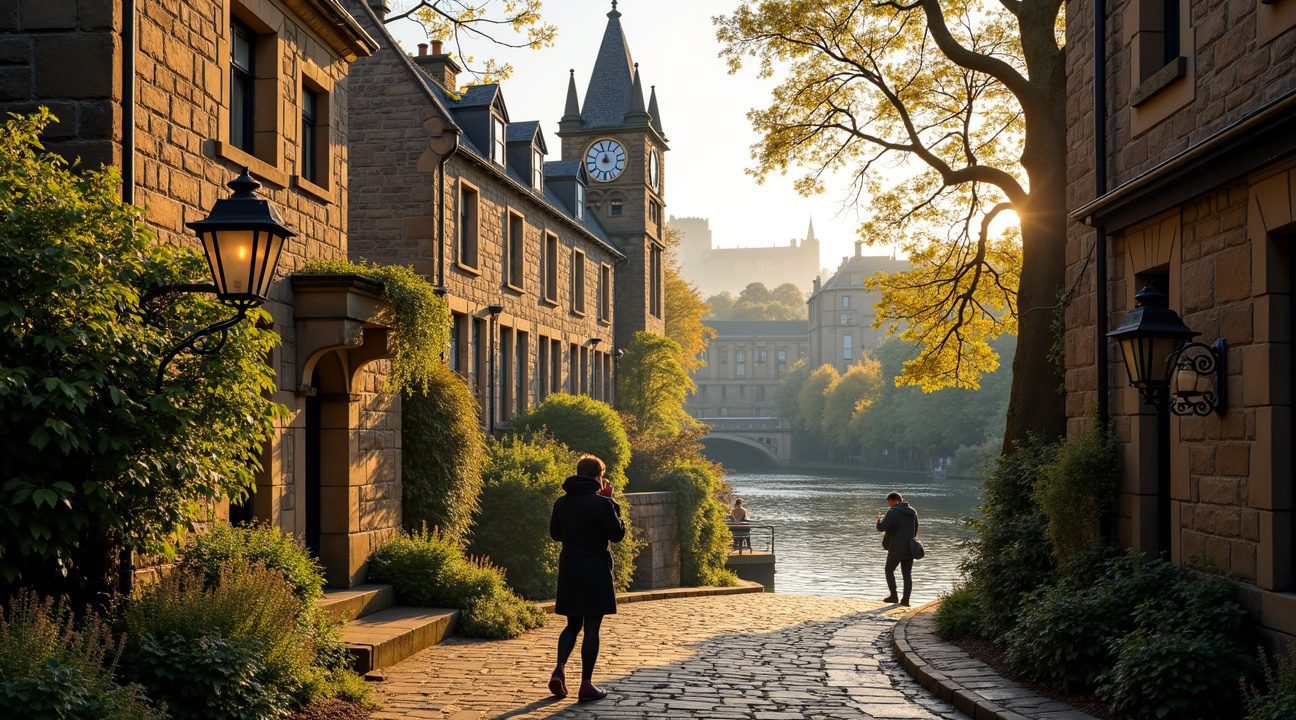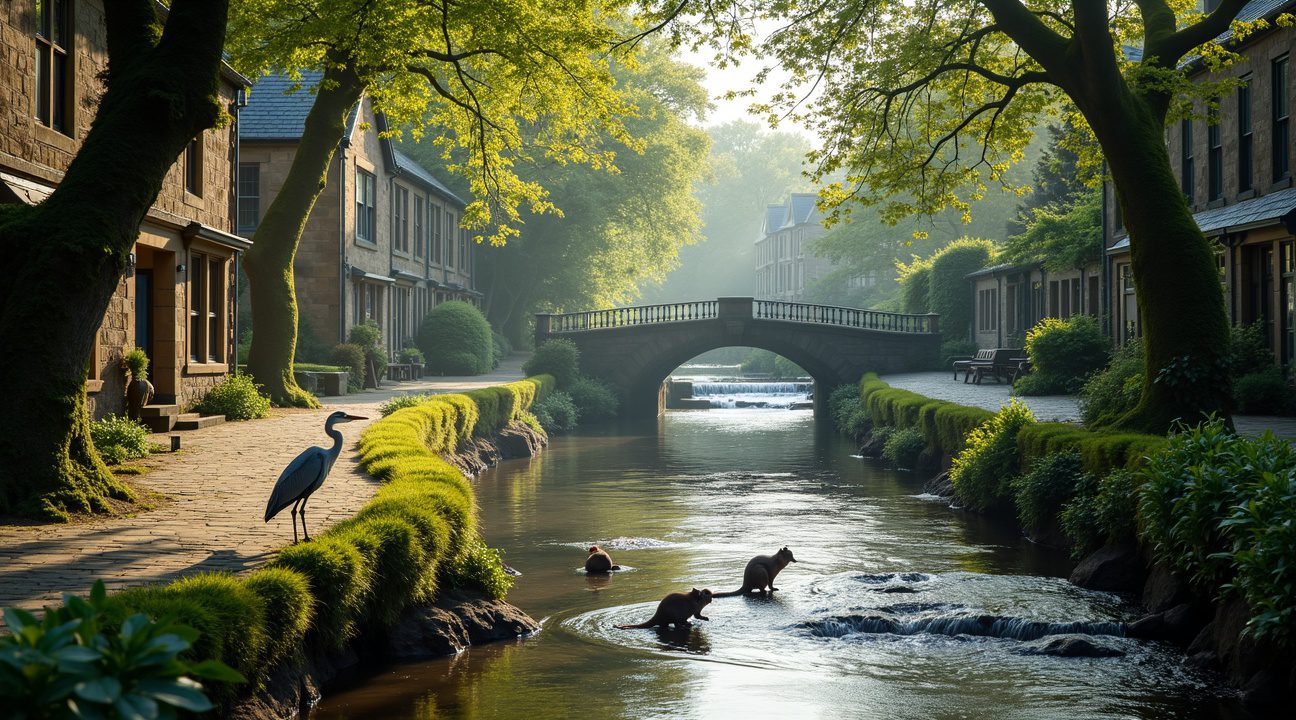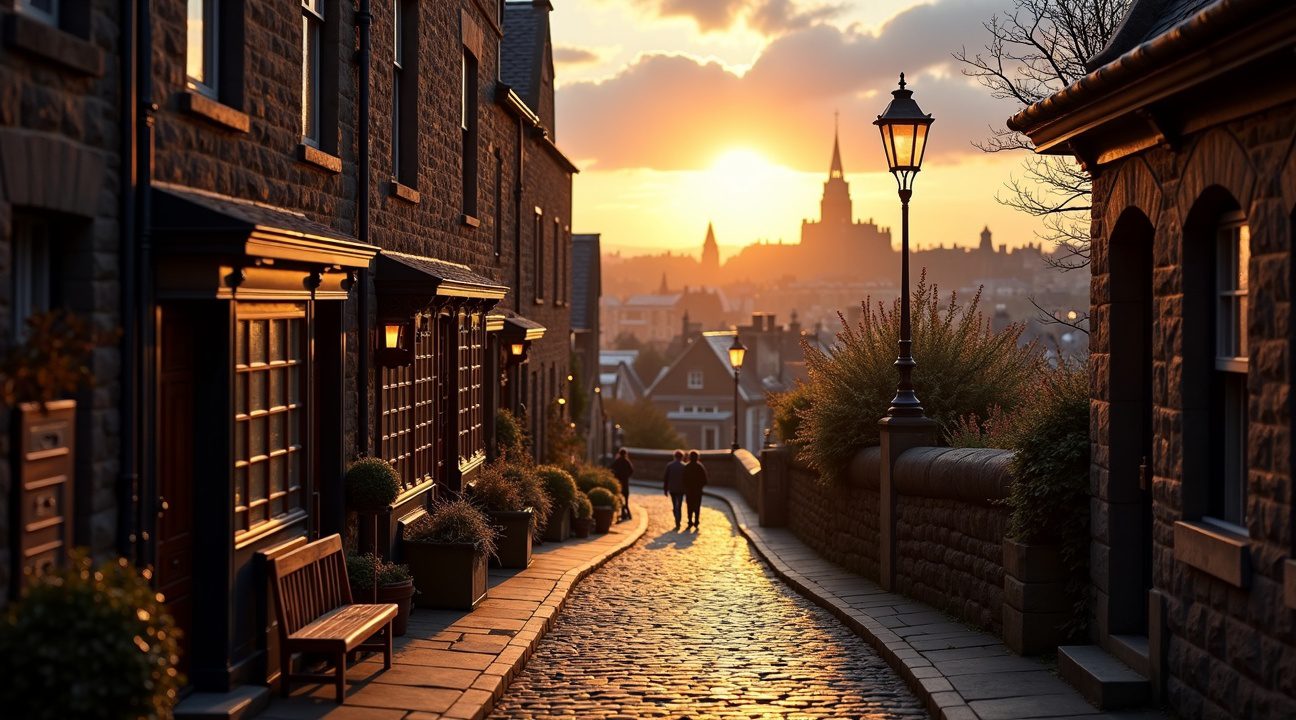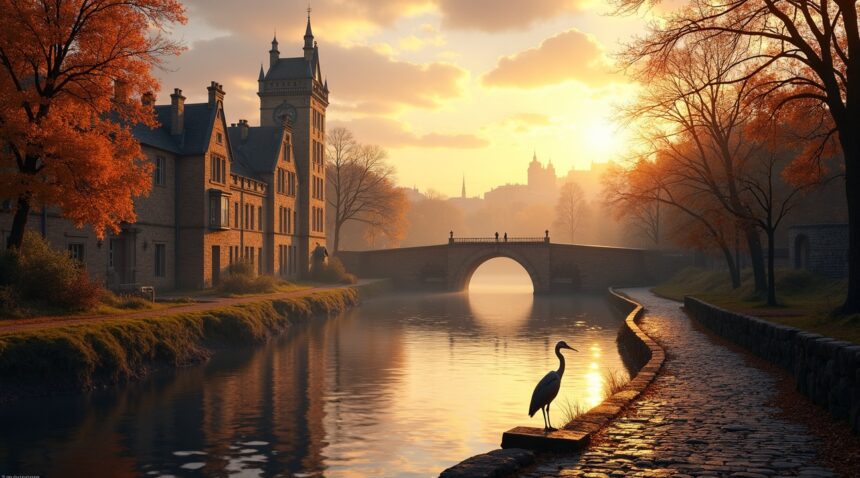Dean Village represents Edinburgh’s most captivating hidden treasure, providing visitors with a perfectly preserved medieval enclave mere minutes from the busy tourist hubs of Princes Street and the Royal Mile.
Key Takeaways
- Dean Village delivers authentic medieval charm with centuries-old sandstone mills and Tudor revival buildings creating a fairy-tale atmosphere beside the Water of Leith, all within a five-minute walk from Princes Street.
- The 12.25-mile Water of Leith Walkway provides wildlife encounters including herons, otters, and kingfishers while connecting hidden neighborhoods like Stockbridge and offering peaceful alternatives to crowded tourist routes.
- Stockbridge Market and independent shops represent where locals actually gather, featuring Saturday markets with artisanal vendors and unique boutiques that display Edinburgh’s authentic community spirit.
- Jupiter Artland and the marble-covered Scotsman Steps demonstrate Edinburgh’s commitment to integrating contemporary art into both countryside and urban settings, offering surprising artistic encounters beyond traditional galleries.
- Free cultural attractions like the Writers’ Museum and Calton Hill’s panoramic viewpoints provide intimate literary experiences and spectacular city views without entrance fees or tourist crowds, making them perfect for authentic Edinburgh exploration.
Dean Village: Edinburgh’s Hidden Riverside Haven Just Minutes from Princes Street
Tucked away just west of Edinburgh’s bustling Princes Street lies Dean Village, a remarkably well-preserved historic enclave that feels worlds apart from the city’s crowded tourist thoroughfares. I’ve discovered this peaceful riverside community offers visitors an extraordinary glimpse into Edinburgh’s industrial past while providing the perfect escape from urban intensity.
The village sits alongside the Water of Leith, where centuries-old sandstone mills create one of Scotland’s most photogenic scenes. These impressive structures, dating back to the 12th century when the area served as the city’s primary grain-milling district, showcase the architectural heritage that makes Edinburgh such a compelling destination. The mill buildings, with their distinctive stonework and riverside positioning, demonstrate how industrial architecture can blend harmoniously with natural surroundings.
Architectural Treasures and Historic Significance
Dean Village’s most striking feature remains its collection of Tudor revival buildings, which create an almost fairy-tale atmosphere along the water’s edge. The Well Court development, completed in the 1880s, stands as a prime example of philanthropic housing from the Victorian era. Its clock tower and ornate stonework provide visitors with exceptional photography opportunities while telling the story of Edinburgh’s social history.
The village’s sandstone mills represent different periods of Scottish architecture, from medieval origins through Victorian renovations. Each building tells part of the larger story of how Edinburgh developed from a collection of separate communities into the unified city visitors know today. Walking through these narrow lanes feels like stepping back in time, yet the area remains just a five-minute stroll from the modern shopping districts of Princes Street.
Natural Beauty and Cultural Connections
The Water of Leith pathway system connects Dean Village to other significant Edinburgh attractions, creating opportunities for extended exploration. I recommend following the riverside walk, which leads visitors through varying landscapes from urban parkland to secluded woodland areas. This pathway system eventually connects to some of the UK’s finest coastal destinations further north.
The Scottish National Gallery of Modern Art sits within easy walking distance, housed in a neoclassical building surrounded by sculpture gardens. This proximity allows visitors to combine their Dean Village exploration with world-class contemporary art viewing. The gallery’s collection includes works by Picasso, Matisse, and significant Scottish artists, making it an essential stop for culture enthusiasts.
Dean Village’s lush natural scenery provides the perfect counterpoint to Edinburgh’s stone-built urban environment. Mature trees line the Water of Leith, creating seasonal displays that transform the village’s appearance throughout the year. Spring brings vibrant green foliage, while autumn creates golden reflections in the water that enhance the sandstone buildings’ warm tones.
The area’s peaceful atmosphere makes it particularly appealing for visitors seeking respite from Edinburgh’s busier attractions. Unlike the crowded Royal Mile or the commercial energy of Princes Street, Dean Village maintains a residential character that allows for quiet contemplation and unhurried photography. This tranquil environment provides excellent opportunities for those interested in solo travel experiences within Edinburgh.
Dean Village demonstrates Edinburgh’s ability to preserve historic character while remaining accessible to modern visitors. The village’s cobblestone streets and ancient buildings create an authentic Scottish experience without requiring extensive travel outside the city center. Its location near Stockbridge also provides access to additional boutique shopping and dining options, extending the exploration possibilities for those who discover this hidden gem.
For visitors planning their Edinburgh itinerary, Dean Village represents an essential stop that captures the city’s unique blend of urban sophistication and historic charm. The contrast between this peaceful enclave and Edinburgh’s more famous attractions illustrates why the Scottish capital continues to captivate travelers seeking both cultural depth and architectural beauty.

The 12.25-Mile Water of Leith Walkway: Wildlife and Waterfalls Through the City
I discovered Edinburgh’s most peaceful escape hidden in plain sight along the Water of Leith Walkway. This remarkable 12.25-mile scenic path weaves through the city center, offering visitors an extraordinary alternative to the crowded Royal Mile and castle grounds.
The walkway transforms urban exploration into a nature immersion experience. I’ve witnessed herons standing motionless along the riverbanks, their patience rivaling that of dedicated photographers. Otters play in the shallow waters during early morning hours, while the flash of electric blue from kingfishers creates magical moments for those walking quietly along the path.
Wildlife Encounters Along the Urban Trail
The diversity of wildlife along this riverside path surprises even seasoned naturalists. I regularly spot the following creatures during my walks:
- Grey herons fishing in the calmer pools near Dean Village
- Otters swimming beneath the stone bridges in early morning
- Kingfishers darting between overhanging branches
- Dippers feeding in the fast-flowing sections
- Red squirrels in the wooded areas near the Royal Botanic Garden
- Various duck species throughout the year
These sightings happen just minutes from Edinburgh’s busy shopping districts, making the experience feel almost surreal.
Connecting Edinburgh’s Hidden Gems
The Water of Leith Walkway functions as a green corridor connecting some of Edinburgh’s most charming neighborhoods. I start my walks in the picturesque Dean Village, where centuries-old buildings create a fairytale atmosphere. The path continues through trendy Stockbridge, perfect for coffee breaks and boutique shopping.
Saughton Park provides expansive green space for longer rest stops, while the approach to the Royal Botanic Garden offers glimpses of exotic plants through the garden’s boundary. Each section presents distinct character and photo opportunities.
The trail includes several small waterfalls and weirs that create soothing background sounds throughout the journey. These water features also attract the wildlife that makes each walk unique. I find the section between Stockbridge and Dean Village particularly enchanting, where Victorian architecture frames the flowing water.
For visitors seeking respite from Edinburgh’s tourist crowds, this walkway provides perfect solace. The path remains accessible year-round, though I recommend waterproof footwear during Scotland’s frequent rain showers. Even famous performers have discovered Edinburgh’s quieter charms beyond the festival stages.
The Water of Leith Walkway proves that Edinburgh’s greatest treasures often lie off the beaten path, waiting for curious explorers willing to trade tourist maps for muddy boots.

Stockbridge Market and Independent Shops: Where Locals Actually Go
I’ve discovered that Stockbridge stands as Edinburgh’s most authentic neighborhood experience, far removed from the crowded tourist trails of the Royal Mile. This charming district pulses with genuine local life, where independent boutiques line cobblestone streets and artisanal vendors create a weekly spectacle that locals guard as their own special secret.
A Market That Captures Edinburgh’s True Spirit
Every Saturday, Stockbridge Market transforms the neighborhood into a food lover’s paradise. I find myself drawn back repeatedly to this gathering where local producers showcase everything from freshly baked sourdough to handcrafted jewelry. The market operates with an intimacy that larger venues simply can’t match — vendors know their customers by name, and conversations flow as freely as the coffee from mobile carts.
The independent shops surrounding the market area offer treasures you won’t find anywhere else in the city. Vintage clothing stores sit alongside contemporary art galleries, while specialty bookshops stock titles from Scottish authors that major chains overlook. These businesses thrive because they serve a community that values quality over quantity, creating an atmosphere where browsing becomes an art form.
What sets Stockbridge apart from other Edinburgh neighborhoods is its seamless blend of urban sophistication and village charm. Young professionals grab their morning coffee from stylish cafes before heading into the city center, while families spend lazy afternoons exploring the tree-lined streets. This demographic mix creates an energy that feels both relaxed and dynamic.
The neighborhood’s proximity to green spaces adds another layer to its appeal. Inverleith Park stretches just beyond the main shopping area, offering expansive lawns where locals walk their dogs and children play cricket. The Royal Botanic Garden sits even closer, its entrance gates practically touching Stockbridge’s northern edge.
I’ve watched tourists stumble upon Stockbridge accidentally and immediately understand why locals keep returning. The area doesn’t try to impress with grand architecture or historical significance. Instead, it wins hearts through genuine character — the kind that develops organically when a community builds something special together. Unlike the more tourist-heavy areas that dominate travel guides, Stockbridge maintains its authentic Edinburgh personality while welcoming visitors who appreciate something different.
For those seeking an authentic European experience, Stockbridge delivers exactly what guidebooks promise but rarely provide: a glimpse into how locals actually live, shop, and gather in one of Scotland’s most beloved cities.
Jupiter Artland and Scotsman Steps: Artistic Surprises Beyond the Galleries
I’ve discovered two extraordinary artistic experiences that showcase Edinburgh’s creative spirit beyond its traditional gallery walls. These hidden gems offer visitors a chance to encounter contemporary art in unexpected settings.
Jupiter Artland: Scotland’s Premier Outdoor Art Destination
Jupiter Artland transforms the Scottish countryside into a living gallery, featuring immersive sculptures and avant-garde installations spread across rolling meadows and ancient woodlands. Located just outside Edinburgh, this outdoor contemporary art park operates from May through September, providing visitors with seasonal access to world-class artistic works.
The park’s strategic location makes it surprisingly accessible for day trips. Public transport connects directly to the site, while those driving will find dedicated parking available on-site. I appreciate how the venue accommodates various visitor needs through its pet-friendly policies and accessible facilities, ensuring everyone can experience these remarkable installations.
What sets Jupiter Artland apart is its integration of art with landscape. Sculptures emerge from natural settings, creating dialogue between human creativity and environmental beauty. The installations change perspectives as visitors move through different seasons, offering fresh experiences with each visit.
Walking through the grounds, I encounter pieces that challenge conventional notions of gallery spaces. Some installations require physical participation, while others invite quiet contemplation. The park’s curators have created an environment where art feels organic rather than imposed, making each discovery feel genuinely surprising.
The venue’s seasonal operation adds urgency to planning visits. During peak months, the interplay between growing vegetation and permanent installations creates dynamic visual relationships. Weather conditions also influence how pieces appear and feel, making no two visits identical.
For those planning first-time European adventures, Jupiter Artland represents Scotland’s innovative approach to public art. The experience extends beyond simple observation, encouraging visitors to reconsider relationships between art, nature, and community spaces.
Scotsman Steps: A Marble-Covered Urban Climb
Meanwhile, back in Edinburgh’s city center, another artistic surprise awaits discovery. The Scotsman Steps represent urban art integration at its finest, proving that creative interventions can transform everyday infrastructure into something extraordinary.
Originally constructed between 1899 and 1902, these steps connect Edinburgh’s Old and New Towns, serving both practical and symbolic functions. Artist Martin Creed reimagined this utilitarian structure by incorporating 104 different types of marble from across the globe into each individual step.
The marble selection creates a geological journey as visitors ascend or descend. Each step presents different colors, patterns, and textures, turning a simple walk into an educational experience about global stone varieties. Creed’s intervention demonstrates how public art can enhance daily urban experiences without disrupting essential infrastructure.
However, I must emphasize caution when using these steps. The marble surfaces can become slippery, particularly during Edinburgh’s frequent rainy periods. Visitors should wear appropriate footwear and take extra care, especially when carrying luggage or walking during wet conditions.
The steps function as both artwork and historical connector, embodying Edinburgh’s character as a city that bridges past and future. Their location between the Old and New Towns makes them impossible to avoid for many visitors, ensuring accidental encounters with contemporary art.
These artistic interventions reflect Edinburgh’s commitment to integrating creativity into daily life. Unlike traditional galleries that require intentional visits, both Jupiter Artland and the Scotsman Steps demonstrate how art can surprise and delight through unexpected encounters.
Both locations prove that Edinburgh’s artistic offerings extend far beyond conventional museum experiences, providing visitors with memorable encounters that blur boundaries between art, architecture, and landscape.
https://www.youtube.com/watch?v=kK12iRG_EiI
https://www.youtube.com/watch?v=Dy_rNPQwLi4
Blackford Hill and Craigmillar Castle: Secret Views and Medieval Adventures
I’ve discovered two of Edinburgh’s most underrated treasures that offer visitors an authentic Scottish experience far from the tourist crowds. The Hermitage of Braid and Blackford Hill provide a remarkable escape into nature, while Craigmillar Castle delivers medieval magic without the hustle of its famous counterpart.
Blackford Hill’s Hidden Panoramic Views
The Hermitage of Braid and Blackford Hill create an unexpected oasis of lush woodland trails just minutes from Edinburgh’s city center. I find this moderately challenging climb rewards visitors with unmatched panoramic views of Edinburgh and the Firth of Forth that rival any paid attraction. Hikers and nature lovers gravitate to these trails because they offer genuine tranquility while remaining easily accessible.
Starting from the Hermitage of Braid visitor center, the ascent takes visitors through diverse landscapes that showcase Scotland’s natural beauty. The summit provides breathtaking vistas that capture Edinburgh’s historic skyline against the backdrop of the distant Forth. Photography enthusiasts particularly appreciate the golden hour lighting that transforms the city into a medieval tapestry below.
Craigmillar Castle’s Medieval Secrets
Craigmillar Castle stands as Edinburgh’s best-kept medieval secret, offering visitors an intimate historical experience that’s less crowded than Edinburgh Castle. This hidden gem showcases exceptional medieval architecture complemented by secret passageways that spark the imagination of every visitor who explores its atmospheric ruins.
The castle’s claim to fame extends beyond its historical significance—it served as a filming location for the popular series Outlander, adding contemporary appeal to its ancient stones. Pop culture enthusiasts often recognize specific scenes shot within these very walls, creating an exciting connection between Scotland’s past and present entertainment.
Winter visits to Craigmillar Castle provide near-total solitude that transforms exploration into an immersive journey through Scotland’s storied past. During these quieter months, visitors can wander the ruins without distraction, allowing the castle’s atmosphere to transport them back centuries. The lack of crowds means photographers capture dramatic shots without modern intrusions, while history buffs enjoy uninterrupted contemplation of medieval life.
Both locations complement Edinburgh’s must-visit European destinations perfectly, offering experiences that showcase Scotland’s natural beauty and rich heritage. Blackford Hill’s panoramic views provide context for understanding Edinburgh’s geographical setting, while Craigmillar Castle’s medieval passages reveal stories that shaped Scotland’s identity. These secret spots prove that Edinburgh’s greatest treasures often hide in plain sight, waiting for curious visitors to discover their magic.
Free Literary Museums and Calton Hill: Cultural Treasures Without the Crowds
I’ve discovered that Edinburgh’s most rewarding cultural experiences often lie beyond the bustling Royal Mile’s main attractions. Hidden gems offer intimate encounters with Scottish literary heritage and breathtaking panoramic views, all without entrance fees or tourist masses.
The Writers’ Museum stands as my favorite literary sanctuary, tucked away in a charming close off the Royal Mile. This intimate venue celebrates Scotland’s literary giants through an impressive collection of rare works and personal artifacts belonging to Robert Burns, Sir Walter Scott, and Robert Louis Stevenson. I find the museum’s quiet atmosphere perfect for appreciating handwritten manuscripts, first editions, and personal belongings that bring these legendary authors to life. The cramped rooms mirror the cozy writing spaces these writers once inhabited, creating an authentic connection to Scotland’s rich literary tradition.
Just steps away, the Museum of Edinburgh provides another peaceful cultural retreat. This lesser-known institution houses fascinating city relics, including the historic National Covenant — a document that shaped Scotland’s religious and political landscape. I appreciate how this museum tells Edinburgh’s story through everyday objects and artifacts that most visitors never encounter. The displays reveal layers of local history often overshadowed by more famous attractions, making it essential for anyone wanting to understand the city’s authentic character.
The National Library of Scotland’s museum deserves special mention for its remarkable collection of historical and Jacobite items. Most tourists overlook this cultural treasure entirely, which means I can explore rare manuscripts, maps, and artifacts in virtual solitude. The Jacobite collection particularly fascinates me, offering insights into Scotland’s tumultuous political past through documents and personal effects that survived centuries of conflict.
Calton Hill: Edinburgh’s Most Accessible Scenic Wonder
Calton Hill represents Edinburgh’s most underappreciated viewpoint, offering spectacular panoramas without the crowds that plague Arthur’s Seat. I consider this elevated park essential for any visitor seeking European destinations that combine accessibility with dramatic scenery.
The hill’s collection of monuments creates a unique architectural landscape against Edinburgh’s skyline. The Dugald Stewart Monument, honoring the influential Scottish philosopher, provides an iconic foreground for photographs featuring Edinburgh Castle, the Balmoral Hotel, and Arthur’s Seat. I find these classical structures particularly striking during golden hour, when warm light transforms the grey stone into glowing focal points.
Sunrise and sunset visits reveal Calton Hill’s true magic. Early morning light bathes the city in soft hues while avoiding afternoon crowds entirely. I recommend arriving thirty minutes before sunset for optimal lighting conditions – the view encompasses Edinburgh Castle’s imposing silhouette, the Balmoral Hotel’s distinctive clock tower, and Arthur’s Seat’s ancient volcanic profile stretching across the horizon.
The hill’s accessibility makes it perfect for photographers and casual visitors alike. Unlike Arthur’s Seat’s challenging climb, Calton Hill requires minimal effort while delivering maximum visual impact. I can reach the summit within ten minutes from Princes Street, making it ideal for travelers with limited time or mobility concerns.
Weather conditions dramatically affect the experience here. Clear days offer views extending to the Pentland Hills and even glimpses of the Forth bridges, while misty conditions create atmospheric photographs with Edinburgh Castle emerging from fog banks. I’ve found that partially cloudy skies often produce the most dramatic lighting for photography.
For those planning longer stays, combining these cultural sites creates a perfect half-day itinerary:
- Start with the literary museums during morning hours when lighting inside is optimal.
- Visit the Writers’ Museum, Museum of Edinburgh, and National Library of Scotland Museum.
- Climb Calton Hill in the afternoon for stunning panoramic views during golden hour or sunset.
This combination showcases Edinburgh’s intellectual heritage alongside its natural beauty, providing experiences that most visitors miss entirely while fighting crowds at more publicized attractions.

Sources:
VisitScotland – “Hidden Gems in Edinburgh”
Tripsget – “Non-Touristy Edinburgh”
Our Crossings – “Hidden Gems in Edinburgh”
Rick Steves – Community Travel Forum: “Must-Sees in Edinburgh”
Kelly Price Writes – “Places to Visit in Edinburgh”
Grumpy Camel – “Unusual Things to Do in Edinburgh”
Happy to Wander – “Things to Do in Edinburgh”


